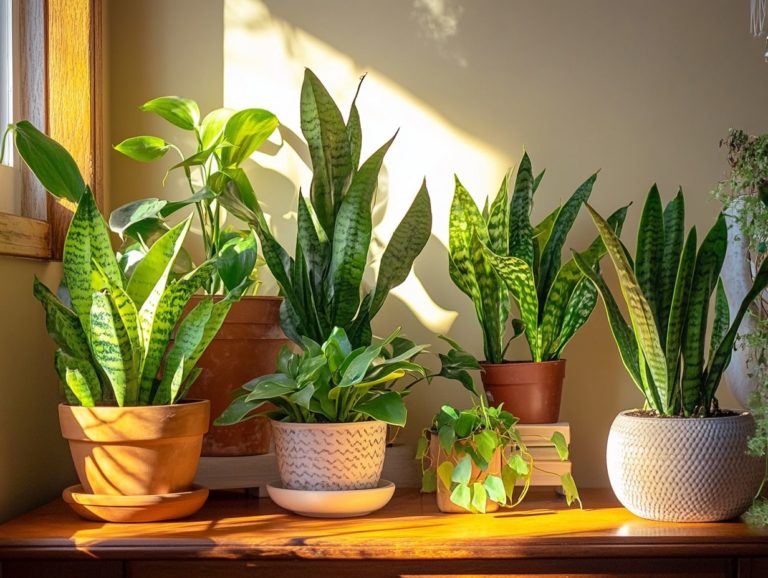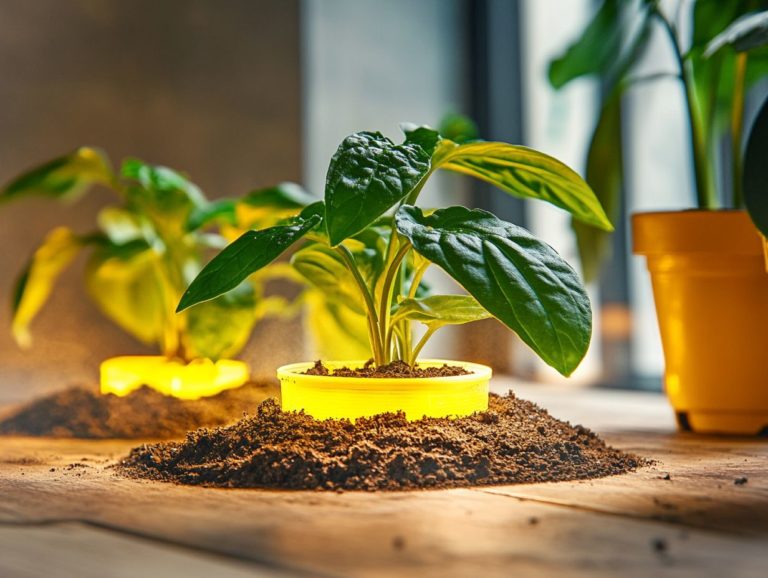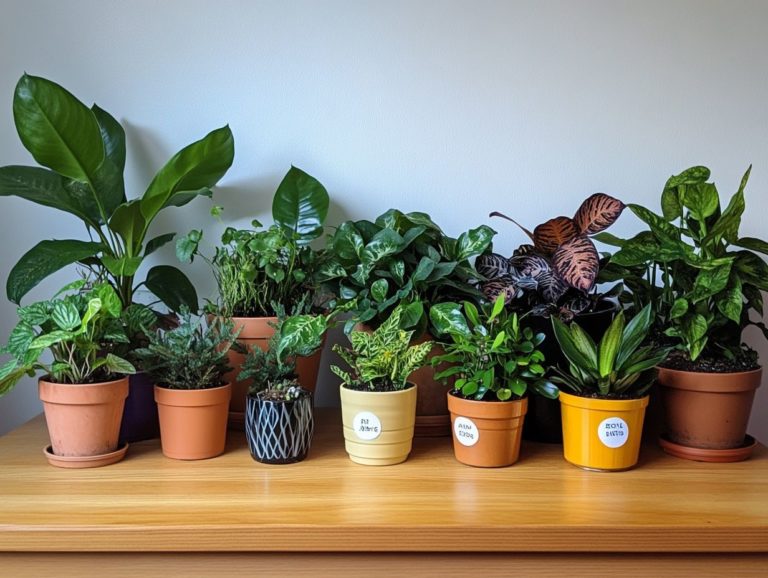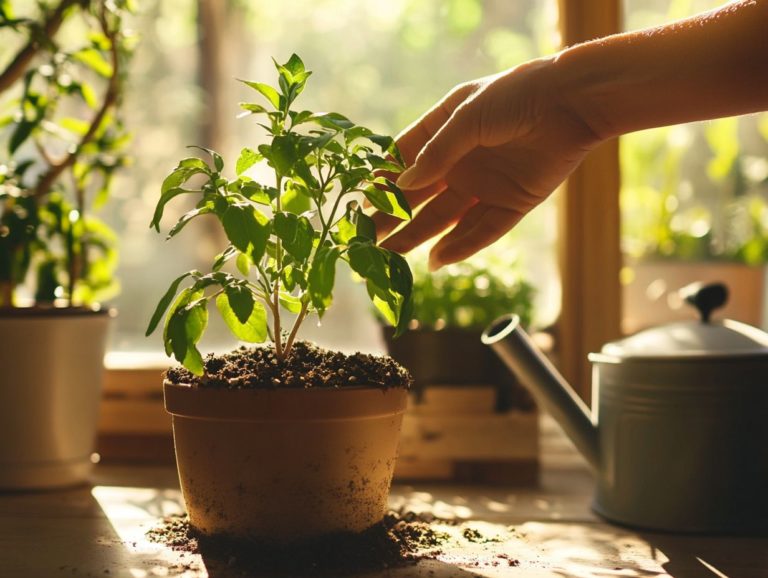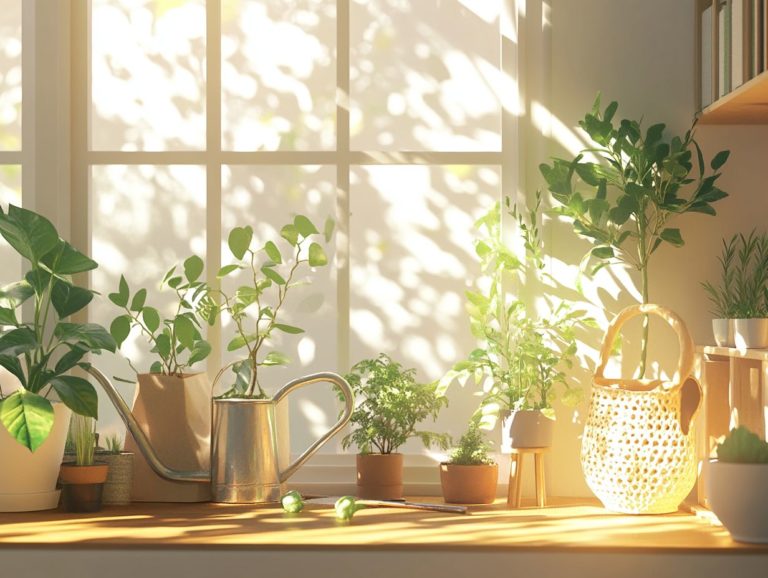How to Trim Indoor Plants for Better Growth?
Indoor plants can infuse vibrancy and life into your space, but maintaining their health involves more than a simple routine of watering and sunlight. Proper plant care techniques are essential for ensuring growth and vitality.
Trimming is important for enhancing their growth, shape, and overall vitality. You should explore the significance of regular trimming, essential tools like pruning shears and pruning knives, and the techniques you’ll need while identifying the optimal times for seasonal pruning.
Watch out for common mistakes to avoid and embrace pruning tips to encourage new growth after a trim, such as preventing overcrowding.
Get ready to transform your indoor garden into a thriving oasis and learn from plant specialists like Egan Thorne and Andi Xoch!
Contents
Key Takeaways:
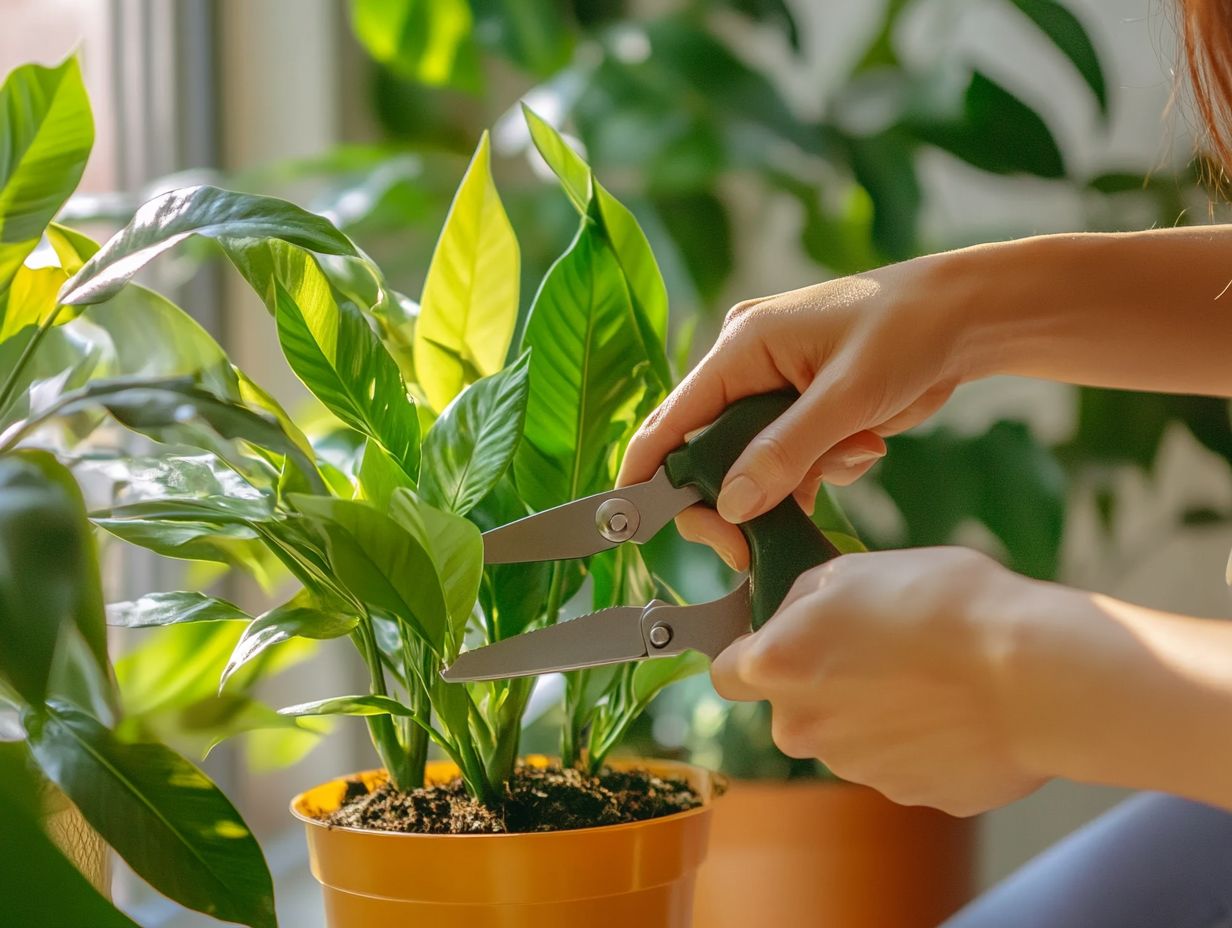
- Regular trimming is essential for indoor plants as it promotes better growth and overall health, making them thrive in your indoor jungle.
- Using the proper tools and techniques for trimming is crucial for the success of different types of plants, including Ficus, Dracaenas, and Tradescantia.
- Trimming should be done at the right time and frequency, particularly in spring and summer, to avoid common mistakes and promote new growth.
Why Trimming is Important for Indoor Plants
Trimming is essential for maintaining the health and vitality of your indoor plants, ensuring they thrive while retaining an aesthetically pleasing shape in your indoor jungle. Regular pruning promotes healthy growth by eliminating dead leaves, yellow leaves, damaged stems, and any compromised parts. This effectively prevents the spread of plant diseases and plant pests.
This practice not only enhances airflow around your houseplants but also encourages the formation of new leaf buds, leading to vibrant, lush foliage as spring and summer unfold. Ultimately, this supports healthy plants.
Benefits of Regular Trimming
Regular trimming offers numerous benefits that enhance the health and vitality of your indoor plants, including improved airflow, a balanced shape, and the prevention of overcrowding. This ensures their aesthetic shape remains appealing.
By committing to consistent pruning, you can encourage better growth patterns, helping each of your plants flourish and reach its full potential, especially with effective pruning techniques. Trimming also enhances the aesthetic appeal, shaping your plants to showcase a more attractive form while allowing light to penetrate deeper into the foliage.
Using techniques like deadheading removing spent flowers to help your plants focus their energy on new growth plays a crucial role in enhancing healthy growth. Maintaining a balanced shape not only supports an appealing appearance but also reduces the risk of disease, as healthier plants are more equipped to fend off pests and ailments, ultimately ensuring robust plant health.
In summary, regular trimming is an invaluable practice for any houseplant enthusiast like you.
Tools and Techniques for Trimming
Equipping yourself with the right tools like pruning shears and gardening shears and mastering the appropriate techniques is essential for effective trimming. This approach not only guarantees clean cuts but also significantly reduces the risk of injuring your plants during the pruning process, emphasizing the importance of hygiene.
Essential Tools for Trimming
Essential tools for trimming your indoor plants include high-quality pruning shears, a sharp pruning knife, and gardening shears. These tools are crucial for effective plant care and maintenance.
They do more than just help maintain the shape and size of your plants; they promote overall health and support effective propagation. When choosing pruning shears, opt for those with comfortable handles to ensure a good grip. This is especially important if you plan to use them for extended periods, as it helps prevent fatigue during maintenance.
A sharp pruning knife is invaluable for cutting away larger branches or tackling delicate tasks, enhancing your plant care routine.
Clean tools are crucial. They significantly reduce the risk of introducing diseases that could spread among your plants if tools become contaminated. Make it a habit to regularly sanitize your equipment with rubbing alcohol to keep your indoor garden thriving and robust.
Proper Techniques for Different Types of Plants

Using the right cutting techniques is essential for various indoor plants, like philodendrons, Pothos, and orchids. This helps achieve successful trimming and unlocks the potential for propagation.
By understanding the specific needs of each plant, including cutting back roots, you’ll see amazing growth. For example, philodendrons flourish when their stems are pruned back during the growing season, resulting in bushier foliage and stimulating new growth.
Orchids require a more nuanced approach; pruning should generally occur after blooming, when the plant enters its dormant phase. This ensures healthy growth thereafter.
Mastering proper pruning techniques nurtures healthier plants and boosts their capacity to produce new roots and flowers. This maximizes propagation potential and overall plant health, paving the way for a vibrant and thriving indoor garden.
When and How Often to Trim Indoor Plants
Understanding the optimal timing and frequency for trimming your indoor plants is essential for preserving their health. This ensures they thrive throughout the seasons.
Seasonal pruning in spring and summer is highly recommended. These seasons foster robust growth and enhance vitality.
Best Times for Trimming
The best times to trim indoor plants are typically in spring and summer, aligning with their growth cycles. These vibrant seasons are when your plants are actively growing and can bounce back swiftly from pruning stress.
With the increased sunlight and warmth, it s the perfect opportunity to rejuvenate your plants. Seasonal pruning helps maintain their shape and size while boosting airflow and light penetration. This leads to healthier foliage.
By concentrating your efforts during these key months, you’ll effectively reduce the risk of disease and promote a fuller, bushier appearance. Regular trimming during these active growth phases encourages your plants to channel their energy into new shoots, resulting in a more robust indoor garden.
Frequency for Different Plants
The frequency of trimming varies significantly among indoor plants. Some plants, like Ficus and Tradescantia, demand more attention than others to maintain their health and appearance.
For instance, Ficus plants often require regular pruning, especially during their active growth periods. This encourages a bushier form and eliminates unsightly leaves, contributing to their vibrant look. In contrast, Pothos plants are quite forgiving. They thrive with less frequent trimming, naturally trailing and tolerating some neglect while still showcasing a vibrant appearance. Tradescantia benefits from consistent pruning to promote healthy, dense foliage and prevent leggy growth, enhancing their overall shape and health.
When it comes to how often you should prune each species, factors like light exposure, growth rate, and overall environmental conditions, including humidity levels, play a crucial role. These elements work together to support the plants’ health and enhance their visual appeal, keeping your indoor garden a stunning focal point in your home.
Common Mistakes to Avoid When Trimming
Avoiding common mistakes while trimming is crucial for maintaining the long-term health of your indoor plants and preserving their aesthetic shape. Be mindful of issues like over-trimming and under-trimming.
These mistakes can impede growth and lead to an unkempt indoor jungle. Keep your plants thriving!
Proper Cutting Techniques
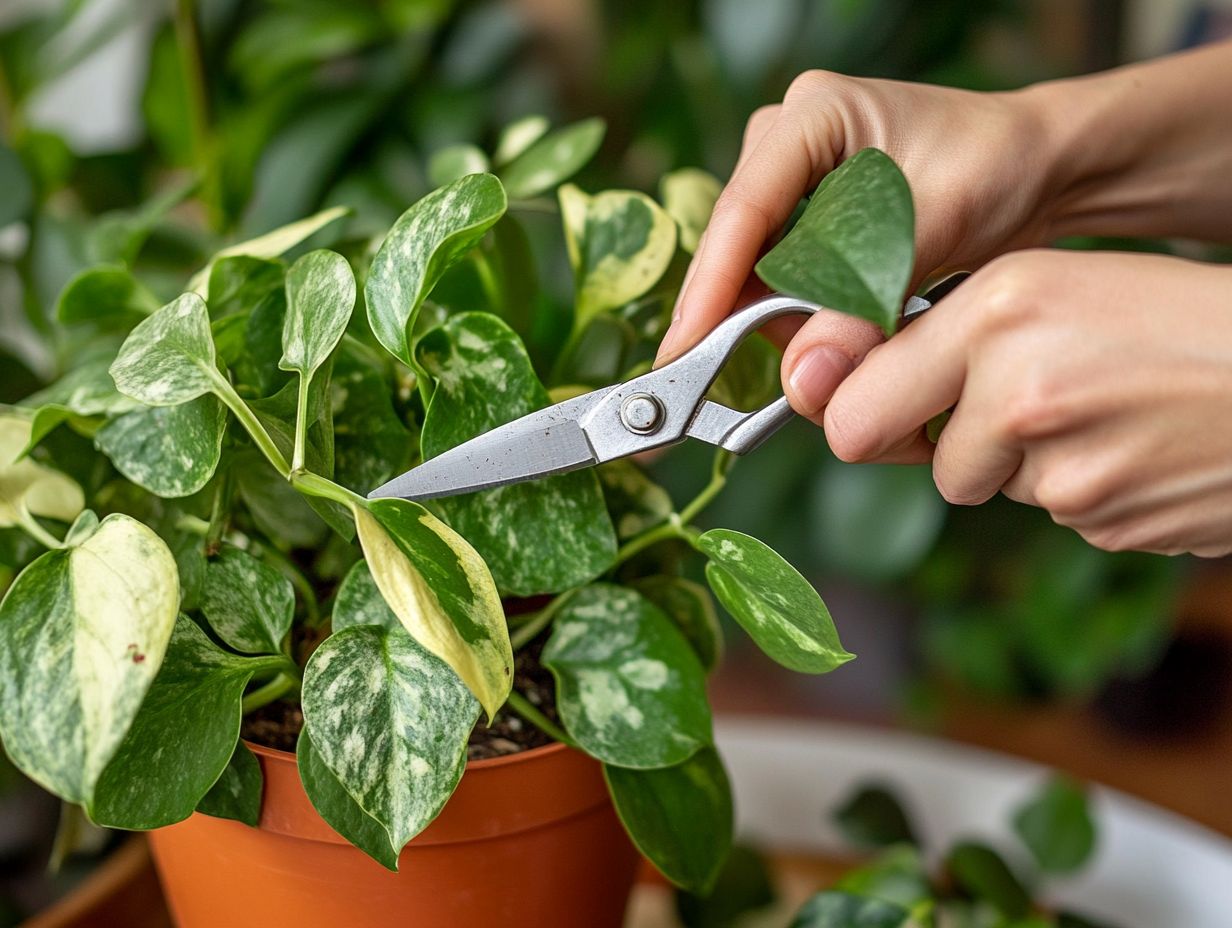
Using proper cutting techniques is essential for achieving clean cuts. This not only promotes plant health but also minimizes the risk of disease and pests. Clean your tools before and after each use to maintain proper hygiene.
When removing dead or yellowing leaves, utilize sharp, sterilized scissors or pruning shears. This minimizes trauma to the healthy parts of the plant and prevents crushing the tissue, which can lead to complications like disease spread. Techniques such as the ‘scissors cut’ or the ‘slant cut’ facilitate better healing, allowing your plants to recover more swiftly and enhance their vitality.
By keeping your tools clean, you eliminate lingering pathogens and protect the overall health of your houseplants. Implementing these methods not only encourages healthier growth but also elevates the aesthetic appeal of your indoor garden, making it a vibrant centerpiece in your home.
Over-Trimming and Under-Trimming
Over-trimming and under-trimming can wreak havoc on your indoor plants. It s essential to strike the right balance during maintenance.
Cutting too much can lead to weak growth, leaving your plants looking sparse and exposed. On the other hand, not trimming enough can create a tangled jungle of branches, stunting development and affecting vitality.
Watch for signs like leggy growth or yellowing leaves. These could mean your plants need a little more trimming. Conversely, if a plant is bursting with foliage but lacks shape, it s a clear sign it s time for a thoughtful pruning.
By regularly assessing these conditions, you help your indoor greenery maintain an attractive shape and thriving health, enhancing the vibrancy of your living space.
Tips for Promoting Growth After Trimming
Promoting healthy growth after trimming requires a clear understanding of the differences between pruning and trimming. It’s essential to implement techniques that foster new growth from leaf nodes and cuttings. Leaf nodes are the small bumps on the stem where leaves grow, while cuttings are pieces of the plant you can use to grow new plants.
By honing these practices, you can ensure that your plants thrive and flourish in the most invigorating ways!
Pruning vs. Trimming
Pruning and trimming may seem similar, but they each have unique roles in promoting healthy growth and maintaining your plants.
When you prune, you cut back branches and stems strategically to promote development and improve air circulation. This practice helps your plants get rid of anything unhealthy, ensuring they are strong and vibrant!
On the other hand, trimming focuses on aesthetics. It shapes and tidies your plants, keeping them at the perfect size and looking just the way you want. Understanding these distinctions can elevate the beauty and vitality of your houseplants, creating a flourishing indoor garden that truly thrives. For more insights, check out best practices for indoor plant care.
Encouraging New Growth
Encouraging new growth after trimming can be effectively achieved by using techniques that stimulate the parts of the plant where leaves grow from the stem and involve strategic cuttings for propagation.
Ensure these areas receive adequate light and moisture so your plant can rebound even stronger than before. Essential nutrients, especially nitrogen, are crucial for supporting new shoots. For example, applying a balanced fertilizer can stimulate growth and build a robust root system. Monitor humidity levels closely; a more humid atmosphere encourages the sprouting of new leaves.
Select healthy stems with a few leaf nodes for cuttings, as they are more likely to thrive in their new setting. Protect these new cuttings from direct sunlight initially to aid in their successful establishment.
Frequently Asked Questions

What are the benefits of trimming indoor plants?
Trimming indoor plants helps promote better growth by removing dead or damaged leaves. This allows more nutrients and energy to be directed toward healthy leaves and encourages the plant to produce new growth while maintaining its desired shape and size.
When is the best time to trim indoor plants?
The best time to trim indoor plants is during their active growing season, typically in spring or early summer. This timing allows the plant to recover quickly and utilize the extra energy for new growth.
How often should I trim my indoor plants?
The frequency of trimming depends on the specific plant species and its growth rate. Generally, it is recommended to trim every 1-2 months to maintain health and shape.
What tools do I need to trim indoor plants?
To trim indoor plants, you will need clean and sharp pruning shears or scissors. Regularly clean and sharpen these tools to prevent the spread of diseases between plants.
Can I use the trimmed leaves for propagation?
Yes, you can propagate trimmed leaves by placing them in water or soil. However, make sure to remove any excess foliage, as it can rot and harm the plant.
Are there any tips for trimming indoor plants?
When trimming indoor plants, make clean cuts just above the node or joint where the leaf or stem meets the main plant. Never remove more than 1/3 of the plant’s foliage at once to avoid shock and stress.
Here are some common questions about trimming indoor plants:

